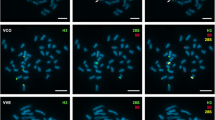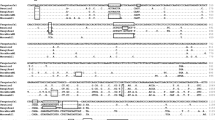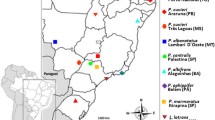Summary
We present a comparison of spacer and coding sequences of histone gene repeats from fourStronglycocentrotus purpuratus individuals. Sequences of two previously cloned units (pCO2 and pSp2) were compared with three new histone gene clones, two of them from a single individual. Within a 1.7-kb region, 59 polymorphic sites were found in spacers, in mRNA nontranslated stretches, and at silent sites in codons of the H4 gene. The permitted silent-site changes were as frequent as in any other region studied. The most abundant polymorphisms were single-base substitutions. The ratio of transitions: tranversions: single-base-pair insertions/deletions was 3∶2∶2. A number of larger insertions/deletions were found, as well as differences in the length of (CTA)n and (CT)n runs. Two of the five cloned repeats contained an insertion of a 195-bp element that is also present at many other sites in the genomes of everyS. purpuratus individual studied. Pairwise comparisons of the different clones indicate that the variation is not uniformly divergent, but ranges from a difference of 0.34% to 3.0% of all nucleotide sites. A parsimonious tree of ancestry constructed from the pariwise comparisons indicates that recombination between the most distantly related repeats has not occurred in the 1–2 million years necessary for accumulation of the variation. The level of sequence variation found within theS. purpuratus population, for both tandemly repeated and single-copy genes, is 25%–50% of that found betweenS. purpuratus andS. drobachiensis.
Similar content being viewed by others
References
Aquadro CF, Greenberg BD (1983) Human mitochondrial DNA variation and evolution: analysis of nucleotide sequences from seven individuals. Genetics 103:287–312
Benton WD, Davis RW (1977) Screening λgt recombinant clones by hybridization to single plaques in situ. Science 196:180–182
Birnstiel ML, Weinberg ES, Pardue ML (1974) Evolution of 9S mRNA sequences. In: Hamkalo BA, Papaconstantinou J (eds) Molecular cytogenetics. Plenum Press, New York London, pp 75–93
Blattner FR, Williams BG, Blechl AE, Denniston-Thompson K, Faber HE, Furlong L, Grunwald DJ, Kiefer DO, Moore DD, Schumm JW, Sheldon EL, Smithies O (1977) Charon phages: safer derivatives of bacteriophage lambda for DNA cloning. Science 196:161–169
Britten RJ, Cetta A, Davidson EH (1978) The single copy DNA sequence polymorphism of the sea urchinStrongylocentrotus purpuratus. Cell 15:1175–1186
Brutlag DL, Clayton J, Friedland P, Kedes LH (1982) SEQ: a nucleotide sequence analysis and recombination system. Nucleic Acids Res 10:279–294
Busslinger MD, Rusconi S, Birnstiel ML (1982) An unusual evolutionary behaviour of a sea urchin histone gene cluster. EMBO J 1:27–33
Childs G, Nocente-McGrath C, Lieber T, Holt C, Knowles J (1982) Sea urchin (Lytechinus pictus) late-stage histone H3 and H4 genes: characterization and mapping of a clustered but nontandemly linked multigene family. Cell 31:383–393
Dover G (1982) Molecular drive: a cohesive mode of species evolution. Nature 299:111–117
Gojobori T, Li W-H, Graur D (1982) Patterns of nucleotide substitution in pseudogenes and functional genes. J Mol Evol 18:360–369
Grosschedl R, Birnstiel ML (1980a) Identification of regulatory sequences in the prelude sequences of an H2A histone gene by study of specific deletion mutantsin vivo. Proc Natl Acad Sci USA 77:1432–1436
Grosschedl R, Birnstiel ML (1980b) Spacer DNA sequences upstream of the TATAAAATA sequence are essential for promotion of H2A histone gene transcriptionin vivo. Proc Natl Acad Sci USA 77:7102–7106
Grosschedl R, Machler M, Rohrer U, Birnstiel ML (1983) A functional component of the sea urchin H2A gene modulator contains an extended sequence homology to vival enhancer. Nucleic Acids Res 11:8123–8136
Grunstein M, Schedl P, Kedes L (1975) Sequence analysis and evolution of sea urchin (Lytechinus pictus andStrongylocentrotus purpuratus) histone H4 messenger RNAs. J Mol Biol 104:323–349
Grunstein M, Diamond KE, Koppel E, Grunstein J (1981) Comparison of the early histone H4 gene sequence and late histone H4 mRNA sequences. Biochemistry 20:1216–1223
Hentschel C, Birnstiel M (1981) The organization and expression of histone gene families. Cell 25:301–313
Hohn B, Murray K (1977) Packaging recombinant DNA molecules into bacteriophage particlesin vitro. Proc Natl Acad Sci USA 74:3259–3263
Joseph DR, Stafford DW (1976) Purification of sea urchin ribosomal RNA genes with a single-strand specific nuclease. Biochim Biophys Acta 418:167–174
Kedes LH (1979) Histone genes and histone messengers. Annu Rev Biochem 48:837–870
Krietman M (1983) Nucleotide polymorphism at the alcohol dehydrogenase locus ofDrosophila melanogaster. Nature 304: 412–417
Maniatis T, Fritsch EF, Sambrook J (1982) In: Molecular cloning: a laboratory manual. Cold Spring Harbor Laboratory, Cold Spring Harbor, New York, pp 117–119
Mauron A, Levy S, Childs G, Kedes LH (1981) Monocistronic transcription is the physiological mechanism of sea urchin embryonic histone gene expression. Mol Cell Biol 1:661–671
Maxam AH, Gilbert W (1980) Sequencing end labeled DNA with base-specific chemical cleavages. Methods Enzymol 65: 499–560
Maxson R, Mohun T, Cohn R, Kedes L (1983a) Expression and organization of histone genes. Annu Rev Genet 17:237–277
Maxson R, Mohun T, Gormezano G, Childs G, Kedes L (1983b) Distinct organizations and patterns of expression of early and late histone gene sets in the sea urchin. Nature 301:120–125
Orkin SH, Kazazian HH Jr, Antonarakis SE, Goff SC, Boehm CD, Sexton JP, Waber PG, Glardina PJV (1982) Linkage of β-thalassaemia mutations and β-globin gene polymorphisms with DNA polymorphisms in human β-globin gene cluster. Nature 296:627–631
Overton C, Weinberg E (1978) Length and sequence heterogeneity of the histone gene repeat unit of the sea urchin,S. purpuratus. Cell 14:247–257
Perler F, Efstratiadis A, Lomedico P, Gilbert W, Kolodner R, Dodgson J (1980) The evolution of genes: the chicken preproinsulin gene. Cell 20:555–566
Petes TD, Botstein D (1977) Simple Mendelian inheritance of the reiterated ribosomal DNA of yeast. Proc Natl Acad Sci USA 74:5091–5095
Poncz M, Schwartz E, Ballantine M, Surrey S (1983) Nucleotide sequence analysis of the β-globin gene region in humans. J Biol Chem 258:11599–11609
Ripley LS (1982) Model for the participation of quasipalindromic DNA sequences in frameshift mutation. Proc Natl Acad Sci USA 79:4128–4132
Scherer S, Davis RW (1980) Recombination of dispersed repeated DNA sequences in yeast. Science 209:1380–1384
Smith GP (1974) Unequal crossover and the evolution of multigene families. Cold Spring Harbor Symp Quant Biol 38: 507–513
Smith GP (1976) Evolution of repeated DNA sequences by unequal crossover. Science 191:528–535
Stafford DW, Bieber D (1975) Concentration of DNA solutions by extraction with 2-butanol. Biochim Biophys Acta 378: 18–21
Streisinger G (1966) Frameshift mutations and the genetic code. Cold Spring Harbor Symp Quant Biol 31:77–84
Sures I, Lowry J, Kedes LH (1978) The DNA sequence of sea urchin (S. purpuratus) H2A, H2B and H3 histone coding and spacer regions. Cell 15:1033–1044
Sures I, Levy S, Kedes LH (1980) Leader sequences ofStrongylocentrotus purpuratus histone mRNAs start at a unique heptanucleotide common to all five histone genes. Proc Natl Acad Sci USA 77:1265–1269
Templeton AR, DeSalle R, Walbot V (1981) Speciation and inferences on rates of molecular evolution from genetic distances. Heredity (Edinburgh) 47:439–442
Thomas M, Cameron JR, Davis RW (1974) Viable molecular hybrids of bacteriophage lambda and eukaryotic DNA. Proc Natl Acad Sci USA 71:4579–4583
Ullrich A, Dull TJ, Gray A, Phillips JA, Peter S (1982) Variation in the sequence and modification state of the human insulin gene flanking regions. Nucleic Acids Res 10:2225–2240
Weinberg ES, Birnstiel ML, Purdom IF, Williamson R (1972) Genes coding for polysomal 9S RNA of sea urchins: conservation and divergence. Nature 240:225–228
Author information
Authors and Affiliations
Rights and permissions
About this article
Cite this article
Yager, L.N., Kaumeyer, J.F. & Weinberg, E.S. Evolving sea urchin histone genes-nucleotide polymorphisms in the H4 gene and spacers ofStrongylocentrotus purpuratus . J Mol Evol 20, 215–226 (1984). https://doi.org/10.1007/BF02104728
Issue Date:
DOI: https://doi.org/10.1007/BF02104728




